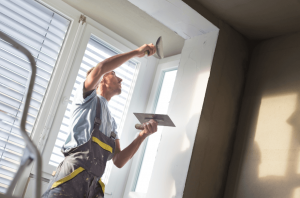Insulation and soundproofing is one approach for improving your home’s comfort. With plastering, you can achieve both benefits. It’s possible to apply plaster to floors, ceilings, and walls to help manage the temperature inside your property. This also lowers the noise level. If you want to get the best benefits, speak to us and work with the most reliable plasterers in Sheffield.
When you use plaster in conjunction with plasterboard, it increases sound absorption qualities. So, less noise will disturb you. This works both ways too, as everyone on the outside won’t hear you as much. Such noise reduction is an essential part of making your property private and peaceful. Let’s look at the topic of plastering for soundproofing in more detail.
Know the basics
 Plastering for soundproofing is perfect if you want comfortable and quiet settings. By knowing the basics of how sound moves as well as the industry terminology, you can make better choices for your home.
Plastering for soundproofing is perfect if you want comfortable and quiet settings. By knowing the basics of how sound moves as well as the industry terminology, you can make better choices for your home.
Key terms for soundproofing via plastering include density. Here, heavier materials typically block sound waves better than lighter ones. With air gaps, sealing them can stop sound waves from moving through surfaces. Then there is vibration absorption. Certain materials convert sound energy into heat. This reduces the energy that they carry.
Using the correct plastering for soundproofing can enhance the sound quality in a room. It is effective because it lowers noise transmission. Specialised acoustic plasterboards and high density materials are crucial to crafting a comforting, quiet setting. Talk to us if you need the greatest plasterers in Sheffield.
High density plasterboard
This does a wonderful job as a sound-deadening material. It has impressive performance thanks to its heavy core. When you utilise plasterboard with a high density, it works to block out external noise. Moreover, it stops sound bouncing around inside a space. Conversations will be clearer. Noises such as TV and music don’t spill from one area to another. The plasterboard’s high density reduces the power of and slows down sound waves.
It’s a versatile option too, as it fits most standard ceiling and wall systems. You can even use it for refurbishments and new builds. Apart from noise reduction, the plasterboard also offers thermal insulation.
Acoustic plasterboard
The alternative is tailored to enhance the acoustic performance of your ceilings and walls. It has a high density core and tends to come with an extra layer that absorbs sound. So, it increases the sound-deadening attributes.
When you use plastering with acoustic plasterboard, you’re introducing an extra layer to stop sound. It helps to create a quieter space. This form of plasterboard has less sound quality and lower noise interference. You can use it in tandem with other insulation materials as well for superior sound control. There are also health benefits. A quieter environment leads to better sleep and less stress.
The right thickness and mass
With plasterboard, you need to choose the right thickness and mass too. The board’s thickness directly influences its soundproofing potential. A heavier, thicker board will typically provide more sound insulation. For instance, employing plasterboard with a thickness of 15mm rather than 12.5mm can make a real difference in lowering noise transfer.
The finest plasterers in Sheffield
At G Lee Plastering, we provide very competitive prices on every service. By doing this, we can encourage clients to return. Not to mention, we always supply excellent workmanship. It will ensure all plaster, render, and other finishes look fantastic.
So, if you’re interested in working with the leading plasterers in Sheffield, give us a call. We’re happy to help with any project, including making homes more comfortable.